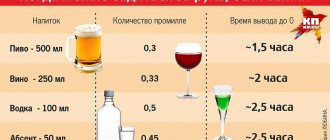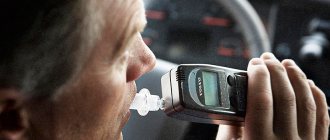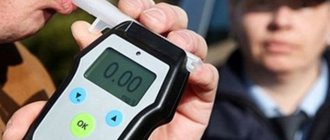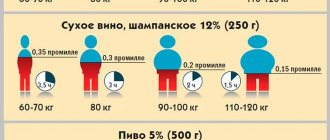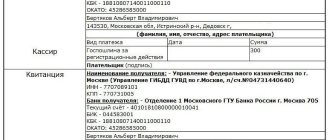What are breathalyzers: how they work
Breathalyzers (alcometers) are measuring instruments that show what percentage of alcohol is contained in the human body through analysis of exhaled vapors. A short test shows whether the driver is drunk and makes it possible to make a decision on the advisability of sending the citizen for a more detailed medical examination.
What does the traffic police breathalyzer show? How much alcohol is contained in the air exhaled by a citizen. Its vapors contact a special sensor, after which the microcomputer displays the final figure on the screen.
different types on the market :
- Depending on the range of potential buyers: personal (purchased by the drivers themselves) and specialized (more powerful and advanced, used by traffic police officers and doctors).
- Depending on the type of sensor (more accurate electrochemical and low-cost semiconductor ).
- Depending on the method of testing ( with or without into which the driver inhales ).
Electrochemical models suggest that the alcohol released by breathing reacts with components inside the device . The numbers shown on the display and demonstrating the degree of intoxication depend on the intensity of its occurrence.
Semiconductor options operate in a different way. They have a built-in tester that releases alcohol vapor from the air entering the device. The numbers on the display change depending on its percentage. Such devices are less accurate because they are not equipped with protection against exhalation simulation.
Features of the use of devices
In order to understand how a breathalyzer works and how much truthful information this device shows, you should consider the nuances of its operation in more detail.
You should also understand the indications, since there are quite a lot of tester models, and they can provide different information, so you need to not only learn to distinguish truth from lies, but also study the characteristics of the effects of alcohol on different organisms, including women and men, since their reaction to alcohol drinks may differ, and you need to know what exactly the differences are.
Permissible blood alcohol limit
A normal level of alcohol is considered to be one at which the person’s condition does not change in any way, that is, the drinks do not raise the level of alcohol in the blood to unacceptable heights.
So, when measuring vapors in the air, 0.16 mg/l can be considered normal, but no more than 0.35 ppm can be detected in the blood.
These two numbers can be called identical, since they correlate with each other, but the blood test can be called more accurate, since only biological fluid is analyzed without the possibility of interference from foreign impurities.
What does a breathalyzer show in ppm or mg/l?
Some people do not distinguish between ppm and mg/l, but there is a significant difference between them. They mainly concern the fact that mg/liter is used in air-based breathalyzers.
It is these devices that are in service with the traffic police, and therefore should be based on them when analyzing the issue of data display.
A high-quality device cannot display ppm, although some models immediately recalculate the obtained analyzes into this unit of measurement, meanwhile displaying both types of information on the screen or printer.
In the protocols drawn up on the spot, only mg/liter is indicated, but ppm will appear in the papers prepared by the physician examining the blood.
How it works
There are several types of breathalyzers, the basic operating methods of which are similar, but differ in the details.
These devices collect a sufficient amount of air exhaled by a person, after which the alcohol, separated from everything else, comes into contact with a special sensor in a technical device.
The result will be an electrical signal processed by a microcomputer, which generates final information about the level of alcohol in the body.
In an electrochemical tester, alcohol from the air is combined with reagents located in the device, after which the chemical reaction affects the strength of the pulse that creates the picture on the display.
In semiconductor versions, the sensor, which is responsible for generating data, heats up, and finally, the infrared tester is able to extract the spectrum of alcohol from the air entering the analyzer, sending the data in the form of a diagram to the screen available on the device.
What dose of alcohol is contained in alcoholic drinks
Before drinking a drink, you should know what proportion of alcohol it contains.
This indicator is called the degree and is indicated on each bottle, for example, vodka and cognac have an indicator of 40%, wine and champagne - 12%, and beer on average has about 5%.
0.6 ppm is how much alcohol you drink, see the article: this is how much 0.6 ppm of alcohol is. How many ppm is considered alcohol intoxication, read here.
But it should be understood that people’s bodies are very different, and the final effect of alcohol on them depends not only on gender, but also on weight.
In men
Men can tolerate more than women, which is why alcohol affects them less than women.
It is necessary to monitor what level of ppm will be in the male body when drinking a certain amount of alcohol, and how this depends on weight.
| Table ppm (weight/drink) | Wine (200 ml) | Beer (500 ml) | Vodka (100 ml) |
| 65 kg | 0,5 | 0,4 | 0,7 |
| 80 kg | 0,4 | 0.35 ppm | 0,6 |
| 95 kg | 0,27 | 0.3 ppm | 0,5 |
| 110 kg | 0,25 | 0.25 ppm | 0,4 |
What does a breathalyzer show: ppm or mg/l?
To determine blood alcohol content and the degree of intoxication, two types of indicators are used:
The first units of measurement are used by physicians when conducting research in a healthcare institution. To do this, blood is taken, the percentage of alcohol is calculated, and the degree of intoxication is determined using special tables.
The second units of measurement are indicated by traffic police officers when conducting a breathalyzer test. They show what percentage of alcohol is in the exhaled air.
The data obtained in two different ways are related to each other. One ppm is approximately two mg/l. For example, a reading of 0.16 mg/l on a breathalyzer used by representatives of the traffic police is equivalent to a blood test reading of 0.35 ppm.
Blood test data is considered more accurate because it eliminates the influence of factors that could affect the test results. If the driver has a dispute with traffic police officers, it is recommended to go for a medical examination to resolve it.
Is there a permissible error in a breathalyzer and how is it determined?
As with any automatic device, there is an error in the breathalyzer. Using this installation, traffic police officers check the degree of intoxication of the car driver. Previously, the permissible error was only 0.05% ppm. State Duma deputies decided to increase this indicator in order to provide protection for certain categories of drivers. In particular, these are citizens suffering from certain pathologies and forced to take alcohol-based medications.
How was the error determined and what does it depend on?
5 years ago, the concept of “error” was enshrined in Russian legislation. The Chairman of the State Duma, after consulting with medical experts, put forward a proposal to set the permissible values at 0.16 mg/l, which is equal to 0.365 ppm. Such measures were designed to protect drivers from arbitrariness by traffic inspectors.
Medical researchers claim that with such an insignificant ethanol content, the driver does not pose a danger to other road users. He behaves adequately, his reaction is not inhibited, his coordination is not impaired.
Professional breathalyzers used by traffic police officers operate using electrochemical and infrared sensors. Household appliances use less accurate semiconductor sensors. Therefore, the difference in performance between such devices is significant.
Breathalyzers detect the presence of alcohol in the driver's blood. The products of the breakdown of ethanol, which poison the body, cannot be detected by devices.
Personal meters are designed to detect residual alcohol during a hangover.
A fine is imposed on the driver when the instrument readings, taking into account permissible errors, are above the norm. The examination is carried out in accordance with the legislation of the Russian Federation, approved registration forms are filled out in the presence of witnesses.
Allowable error
Any device, even the most expensive and having excellent characteristics, has an error. The only difference between household appliances and professional ones is that high-precision breathalyzers used during examinations by traffic police meet established standards.
At personal breathalyzers
For appliances that are used for personal use, there is no certain degree of error. As a rule, it fluctuates depending on the dose of alcohol consumed.
If a small amount of alcohol was drunk (up to 0.5 ppm), the difference in indicators is no more than 0.1 ppm. When drinking alcohol in large doses, the difference can be 20% or more.
Personal breathalyzers with an electrochemical sensor, which are used by state traffic inspectors, have a smaller error, which means that their results should be trusted more.
With a low blood alcohol content, up to 1 ppm, the error will be only 0.05 ppm. With large dosages of alcohol, the error increases to 10%.
From professional
Special types of breathalyzers that have a professional purpose, have high sensitivity and have the most reduced errors.
The documentation for the devices indicates that their accuracy for blood alcohol levels from 0.00 to 0.48 mg/l is only 0.05 mg/l. At high alcohol concentrations from 0.48 to 0.95 mg/l, the error is 10%.
Professional breathalyzers show the presence of alcohol vapor in the exhaled air. It is important to carry out the inspection in accordance with the rules specified in the documentation for the device. Only in this case will it be possible to obtain reliable results. Due to their accuracy, the devices are included in the State Register of Measuring Instruments.
In a court
The Supreme Court of Russia adopted new amendments to the legislation, according to which medical workers are required to take into account the error of measuring instruments when examining drunk drivers.
Previously, in accordance with the instructions for conducting a medical examination, the driver was deprived of the right to drive vehicles only for positive indicators of the device.
In fact, even a driver who, for example, drank a bottle of kvass or a packet of kefir could be left without a license. That is why amendments were made to legitimize the error in the Code of Administrative Offenses of the Russian Federation.
Your Narcologist warns: is the value of 0.365 ppm dangerous?
Medical researchers have not identified any disturbances in the reaction and coordination of a person whose blood contains up to 0.365 ppm of alcohol. The reaction speed remains at the same level, coordination of movements is not impaired, attention is at the same level. Such a person does not pose a danger to other road users. At the same time, the smell of alcohol may emanate from such a driver.
Indicators of ethanol content in the blood also increase due to the characteristics of a number of pathologies. If a person is in a stressful situation, very hungry or hypothermic, this can also provoke an increase in values that will be taken into account when making a decision.
A large amount of kvass or kefir drunk can provoke an increase in the value of the device.
Breathalyzer error, depending on sensor type
There are several types of devices that differ in the way they perceive information:
- Semiconductor sensors. A possible error of 20% does not allow them to be used to prove the driver’s alcohol intoxication in court. Personal use is acceptable. The use of the device is permitted no more than once a day. Otherwise, the indicators will differ from the real ones.
- Thermocatalytic meters. These are also semiconductor sensors, but they have a reduced error of 10%. The main disadvantages of such sensors are their fragility and rapid failure.
- Electrochemical sensors. These are professional devices approved for use on roads by State Traffic Safety Inspectorate officers. A difference of 10% allows you to determine whether a motorist is intoxicated and prove the fact of driving under the influence in court.
- Spectrometers. They give fairly truthful results, but are capricious to temperature changes and other conditions in which they are used. Therefore, their use on roads is irrational.
The error of breathalyzers is a problem that worries citizens and the state. After introducing the difference in values, Rosstandart was instructed to monitor the technical characteristics of the equipment used.
What external factors influence breathalyzer readings?
The devices used by traffic police representatives show the concentration of alcohol in the air vapor exhaled by the motorist, but do not explain its origin . This causes errors and inaccuracies associated with the rapid test. There are the following factors leading to distortion of its results:
- Dangerous drinks
You should not believe advertising: the percentage of alcohol in non-alcoholic beer is not zero, so after drinking it, a breathalyzer shows up to 0.1 mg/l. Food products, such as kefir, have a similar effect. Experts advise drivers to avoid drinking drinks with liqueurs or sweets with alcohol filling before traveling.
Equipment readings are affected by citrus fruits, bananas, Borodino bread, cakes and pastries. If traffic police officers conduct a test, its result will reach 0.15 mg/l.
- Pharmaceuticals
If medications are alcohol-based (for example, motherwort, valerian), their use affects the breathalyzer values. A refreshing mouth spray has a similar effect.
- Features of the body
The high level of endogenous alcohol is due to the peculiarities of metabolism in the body. If the breathalyzer shows an excess, a blood test will help to understand the situation.
- Instrument error
Even expensive equipment used by law enforcement agencies has measurement errors. According to rough estimates, it reaches 0.05 mg/l. An error made during the inspection may result in an administrative case being exceeded in 2021. Other factors that affect accuracy include wear on the breathalyzer, hot weather, or high humidity.
- Fraud by traffic police officers
The capture of a drunk driver is the merit of the traffic police inspector. To hold a citizen accountable, he can lubricate the surface of the mouthpiece with alcohol. If a motorist is sure that he did not drink alcohol before the trip, he should carefully check the cleanliness of the equipment and, if a dispute arises, request a medical examination.
Allowable error
Any device, even the most expensive and having excellent characteristics, has an error. The only difference between household appliances and professional ones is that high-precision breathalyzers used during examinations by traffic police meet established standards.
At personal breathalyzers
For appliances that are used for personal use, there is no certain degree of error. As a rule, it fluctuates depending on the dose of alcohol consumed.
If a small amount of alcohol was drunk (up to 0.5 ppm), the difference in indicators is no more than 0.1 ppm. When drinking alcohol in large doses, the difference can be 20% or more.
Personal breathalyzers with an electrochemical sensor, which are used by state traffic inspectors, have a smaller error, which means that their results should be trusted more.
With a low blood alcohol content, up to 1 ppm, the error will be only 0.05 ppm. With large dosages of alcohol, the error increases to 10%.
From professional
Special types of breathalyzers that have a professional purpose, have high sensitivity and have the most reduced errors.
The documentation for the devices indicates that their accuracy for blood alcohol levels from 0.00 to 0.48 mg/l is only 0.05 mg/l. At high alcohol concentrations from 0.48 to 0.95 mg/l, the error is 10%.
Professional breathalyzers show the presence of alcohol vapor in the exhaled air. It is important to carry out the inspection in accordance with the rules specified in the documentation for the device. Only in this case will it be possible to obtain reliable results. Due to their accuracy, the devices are included in the State Register of Measuring Instruments.
In a court
The Supreme Court of Russia adopted new amendments to the legislation, according to which medical workers are required to take into account the error of measuring instruments when examining drunk drivers.
Previously, in accordance with the instructions for conducting a medical examination, the driver was deprived of the right to drive vehicles only for positive indicators of the device.
In fact, even a driver who, for example, drank a bottle of kvass or a packet of kefir could be left without a license. That is why amendments were made to legitimize the error in the Code of Administrative Offenses of the Russian Federation.
If there is fumes, what will the breathalyzer show?
A breathalyzer test is one of the grounds for bringing a motorist to justice. The final decision is made by the road inspector, analyzing the appearance, speech and behavior of the citizen. After heavy libations, you won’t be able to avoid a fine, but if you drink one glass of wine in the evening, you can try to “deceive” the device.
To do this, it is recommended to snack on alcohol with fatty foods, which slow down the absorption of alcohol into the blood. If the driver's appearance does not arouse suspicion, the inspector will not check the driver using specialized equipment.
Folk remedies that help remove fumes include coffee beans, fresh mint or parsley leaves, ginger, garlic . A proven pharmaceutical product – “Anti-policeman”. These recipes will not reduce the alcohol content in the exhaled air, but will help convince the inspector of the driver’s sobriety before using the device.
How long will it take for a breathalyzer to show alcohol?
It is impossible to say with absolute accuracy how much time must pass from the feast to the test so that you can use a breathalyzer without the risk of seeing an increased ethanol content in the blood. The time it takes for alcohol to be eliminated from the body depends on many factors, namely:
- on the type of alcohol consumed and its quantity;
- depending on age, the older a person is, the slower alcohol leaves his body;
- from the state of health - with chronic diseases of the liver and kidneys, alcohol stays in the body longer;
- from gender - in the female body, alcohol breaks down more slowly;
- from weight - intoxication goes away faster in large people with high body weight;
- from the weather outside - in hot weather, alcohol remains in the body longer than in cold weather.
If we take as an example an adult man who does not suffer from chronic diseases, with a body weight of about 60-70 kg, then a glass of light beer will be eliminated from his body in about 3 hours, and 100 ml of vodka - in 6 hours.
The greater the amount of alcohol consumed, the longer the ethanol will remain in the body. For example, after drinking copious amounts of half a liter of vodka, you will have to stop driving for 3 days.
Important! A personal breathalyzer is needed precisely in order to understand whether it is safe to drive or whether you should wait. The maximum permissible level for a driver is 0.16 ppm in the blood when tested; higher results indicate intoxication.
You should not use the device unless there is a real need - this reduces its accuracy
Where is a breathalyzer used?
A breathalyzer is a device that determines the degree of intoxication. It's no secret that even a small amount of alcohol can cause lethargy, an increased desire to sleep, and negatively affect alertness. It is obvious that a drunk person in a car poses a danger to himself and the people around him. That is why special attention is paid to this issue, and violations of the rules are severely prosecuted by law.
Most often, a breathalyzer is needed by transport police to determine the sobriety of motorists on the road, but the device is widely used in other areas.
- Transport organizations check their drivers before setting out on a route.
- Drivers of school buses and other municipal institutions are subject to similar checks.
- The device is used when legal disputes arise.
- Employees of public and private companies involved in working with harmful and dangerous substances, as well as complex mechanisms or working in extreme conditions are subject to periodic inspections.
- A breathalyzer is also needed to monitor problem children and teenagers.
The areas listed above are far from the only places where the device is used. A breathalyzer can be useful for the most ordinary driver, because there are often cases when the next morning after a holiday it is necessary to drive a car, and at the same time there can be no confidence that there is no alcohol left in the blood without a test.
Devices used by traffic police officers
The traffic police breathalyzer is an exclusively professional device, designed for repeated use throughout the day and has high accuracy of readings.
The traffic police breathalyzer is an exclusively professional device, designed for repeated use throughout the day and has high accuracy of readings. The devices operate on the same principle (the reaction of an electrochemical indicator to the air exhaled by the driver). That is, inside the device there are two active platinum plates treated with catalysts. When exhaled air vapor with ethanol in it hits them, the catalyst weakens the bonds in the ethanol molecules. As a result of exhalation, a positive charge is formed on the first plate and a negative charge on the second. Thus, a current discharge is formed, which will have a force proportional to the number of ethanol molecules that reacted with the catalyst.
What is the difference between a breathalyzer and a breathalyzer?
In Russia, several types and models of devices are approved for testing violators on the roads. These are:
- Breathalyzer Alcotest 6810 from German. Devices may have a printer or operate without one. As a rule, Alcotest breathalyzers have small parameters (about 11 cm in length), but at the same time they are quite expensive (about 900 USD). The operating temperature range of such a device is -5—+50 degrees Celsius.
- Alcotest 7410 plus device. The mechanism can operate in a temperature range of -5—+45 degrees. The maximum error for such a breathalyzer is 5%. In this case, the device maintains a pause between testing and using the device again from 10 to 90 seconds (the pause depends on the result of the previous test).
The PRO-100 Combi has excellent memory and is capable of storing up to 2000 previously obtained results
- Device PRO-100 Combi. Such a device has excellent memory and is capable of storing up to 2000 previously obtained results. The device is equipped with a printer that prints 1 to 3 test copies at a time. The breathalyzer is also equipped with 105 disposable mouthpieces. The period for displaying results does not exceed 5 seconds. The permissible error shown by the device is 10%. It gains strength if the alcohol test is in the range of 0.475-0.95 mg/l. The device looks like an elongated box 19 cm long.
- LION device (SD-400P). The technical characteristics of such a device are close to the characteristics of the PRO-100 Combi tester. In this case, the mechanism can withstand only 20 seconds between two tests. The breathalyzer box weighs about 500 grams.
- Canadian device Alert J4 Xec. A pause of 15 seconds is required between two tests. The device operates at temperatures from -5 to +40 degrees. The sensor is cleaned within 1 minute.
- The AKPE-01 M device operates on the principle of interaction of ethanol with the infrared radiation of the device. The error is about 10%. At the same time, the device takes longer to prepare for operation than others. On average it takes about 3.5 minutes. There is a pause of about 15 seconds between two tests.
Important: if a traffic police officer offers you any other device for analysis, you have the right to ask for the appropriate document indicating that the device is included in the list of acceptable devices according to the permission of the Ministry of Health. If the traffic police inspector does not have such paper, the driver has the right to refuse testing for the reason that the device is being used illegally, and its testimony cannot be used as evidence when initiating legal proceedings.
Types of testers
The breathalyzer works using sensors that measure the level of alcohol-containing substances in the air . When a person drinks alcohol, it is carried through the blood to all parts of the body, including the lungs, and from them the alcohol remains in the air that the driver exhales. Sensors are divided into several types.
- Semiconductor (characterized by the lowest accuracy), deviations in the accuracy of readings up to 20%.
- Electrochemical (the most accurate data), error - up to 0.01 ppm or no more than 10% of the final result.
- Infrared, photometric (they do not lose their functions over time, this is why they compare favorably with the first type), the error of the breathalyzer is up to 10%.
All devices come with or without a mouthpiece. Models without a mouthpiece are called non-contact, since the subject, when exhaling, holds the device at a distance of no more than 2 cm from the mouth and blows into a special hole.
Important! Devices without a mouthpiece are considered less accurate, since in this case part of the exhaled air is scattered, and it is not possible to determine the exact level of ethanol.
A breathalyzer with a mouthpiece is a contact version, where the user places a plastic straw between the lips and blows into it. The air is not dissipated and the results are more accurate. For hygiene purposes, the kit may contain several replaceable plastic straws.
How does a breathalyzer work?
The instructions for the device give an understanding of how to use a breathalyzer of one type or another, but in general the process is quite similar.
- The device is turned on using a special button.
- The mouthpiece is connected.
- The person being tested breathes into the tube until a double beep sounds.
- The processor calculates the amount of ethanol and displays the result on the screen.
On a note! Depending on the device, the designation of the indicator may be different - in ppm, mg/liter, fractions of percent.
As mentioned above, the operating principle of the breathalyzer is based on determining the amount of ethanol in the air that the test subject exhales. Based on this, it is possible to find out how drunk he was when he drank alcohol, as well as how much alcohol remained in his blood if the drinks were taken on the eve of the trip. When air enters the device, the sensor transmits a signal to a special processor, which carries out specific final calculations. The sensors themselves analyze the air in different ways:
- electrochemical monitors the reaction of reagents to the ethanol contained;
- semiconductors analyze the amount of heat released as a result of a chemical process that begins when alcohol is present in the body;
- infrared detect ethanol vapors.
Valid values
Below is a table with blood alcohol content and the body's possible reaction.
| Breathalyzer readings in ppm | Degree of intoxication | Symptoms |
It is worth noting that 3.5 ppm is considered a lethal dose for humans. Depending on the type of device, the designation may be displayed in digital values, the screen color changes (green, yellow, red), and an arrow on the table indicates the result.
Important! Before agreeing to undergo the test, the car enthusiast should know that Russian legislation allows 0.365 ppm, which is equivalent to 0.16 ml/liter. In Europe, the acceptable value is 0.8 ppm.
How to breathe correctly into a breathalyzer?
When a traffic police officer inserts a disposable mouthpiece into the device, you must blow strongly into it. The device will start beeping and the display will show “Blow”. You need to blow into the mouthpiece for about 5-7 seconds. When the breathalyzer makes a click, this indicates that the procedure is complete, and the message “Wait” will appear on the screen. After a few seconds, a digital value will appear on the screen, which will indicate the percentage of alcohol in the blood serum.
The percentage of ethyl alcohol in the blood is measured in ppm. If the breathalyzer shows a value greater than 0.2 ppm, this indicates that the concentration of alcohol in the blood is above the permissible limit.
Why a breathalyzer may give incorrect readings
There is a situation in which a police officer stops a driver and asks him to take an alcohol test. The motorist, fully confident that he is not in danger, because he really did not drink, agrees to the test, and the breathalyzer shows that there is ethanol in the blood. It is important to know that some drinks and foods can cause a similar reaction and give a false result, and in addition, some people have a slightly higher reading for health reasons. To avoid misunderstandings and erroneous punishment, you should know what can cause a reaction from the tester:
- soft drinks (kvass or beer);
- pharmaceutical products containing alcohol;
- candies with alcohol (tests were carried out, and the result showed that four candies leave a trace, which completely disappears only an hour after consumption);
- kefir or yogurt;
- raisins or grapes, which can cause fermentation in the stomach;
- black bread, overripe bananas, oranges, desserts;
- regularly used inhalers;
- a cigarette can add two hundredths to the final result.
Why is calibration performed?
Breathalyzer calibration is a mandatory procedure for models that have multiple uses . Laboratory studies have shown that every test on any type of tester affects the condition of the sensor, reducing its sensitivity. This point is indicated in the description of the device. Another nuance shows that the tester can malfunction and begin to show inaccurate data if saliva is deliberately placed in it or tobacco smoke is exhaled. As a rule, the instructions indicate the service life of the breathalyzer, as well as when it is necessary to adjust the sensitivity of the sensor or completely replace it. Some models have a self-diagnostic function and can indicate the need for calibration.
Models with a semiconductor sensor need to be tested and the sensor replaced after 200-300 checks, provided that professional devices are used 20-30 times a day, and individual devices - 2-3 times a day. If the frequency of use is significantly less, then checking the breathalyzer and calibrating it is needed once a year. Professional models are sent to special metrological services after every 500-1500 uses, depending on the frequency of daily use.
On a note! You can repair a personal breathalyzer yourself; you just need to buy a new sensor.
Do-it-yourself breathalyzer calibration
Regardless of the type and cost, all breathalyzers are equipped with a sensitive sensor on the inside. It can be semiconductor or electrochemical, infrared, in any case, the accuracy of the measurements carried out by the device depends on it.
Both budget and the best breathalyzers have a weak point - the sensitivity of their sensors decreases over time. Each use of the device leads to the fact that the sensitivity of the sensor slightly deteriorates - and if at first you can use it in the same way, without distorting the results, then sooner or later the breathalyzer will begin to give incorrect readings. Additionally, the sensitivity of the sensor is reduced by too frequent use of the device, contact of the sensor with air, the concentration of ethanol vapor, which is very high, as well as blowing air through the sensor mixed with cigarette smoke or saliva.
If an electronic breathalyzer begins to provide incorrect readings, there is no need to throw it away; it is enough to calibrate the device to use it again. Calibration involves re-adjusting or replacing the sensitive sensor, after which the device is ready for use again and shows results with maximum accuracy.
Budget models can often be calibrated at home
Owners of individual and professional breathalyzers are interested in performing calibration themselves without involving a service center. In some cases this is indeed possible.
Many models of personal breathalyzers have a removable cover on the back of the case, under which the sensitive sensor is hidden. If the device belongs to this type, then for calibration it is enough:
- remove the cover;
- Gently grab the small semiconductor sensor with your fingers and pull it out of the socket;
- put in its place a previously purchased new sensor, preferably exactly the same one;
- close the lid and turn on the device.
After replacing the sensor, a device with a replaceable sensor will be completely ready to use; no additional manipulations will be required on it.
Unfortunately, not all breathalyzers can be self-calibrated. Professional category devices and individual devices without access to the sensor, for example, the Driver Safe breathalyzer, will have to be sent to a service center - there is no way to calibrate them at home. The sensor adjustment should be carried out by specialists who, using the equipment, will be able to return the sensitivity to the sensor and bring it into compliance with the established standard.
Attention! The calibration frequency for the breathalyzer is indicated in the instructions for the device.
It depends on the class and degree of reliability of the device - inexpensive semiconductor breathalyzers are recommended to be calibrated after every 200 checks, premium devices must be calibrated once every few months.
It is impossible to calibrate professional-level devices with your own hands
Common Myths
There are some myths and misconceptions among drivers that sometimes make them want to take risks and go on a trip after drinking alcohol. The most popular of them are collected below. It is worth familiarizing yourself with the list so as not to get into the unpleasant situation of deprivation of rights due to a stupid mistake.
- There is a myth that the tester will not show beer - this is a misconception; any alcohol-containing drink produces ethanol in the blood.
- Food in large quantities neutralizes alcohols.
- Belching also does not improve the alcohol content situation.
- Chewing gum, sprays, and aerosols that can mask the odor are not able to remove traces of alcoholic beverages.
- A battery or a copper coin is another stupid myth, and the presence of such objects in the mouth will definitely raise questions from traffic police inspectors.
As a conclusion, it is worth noting that no matter how the driver feels immediately after or the morning after drinking alcohol, you should not neglect your own and other people’s lives, and also spoil your future. There are no situations in which driving out is a necessity and worth the risk. And the question is not even about the possibility of being caught, but in relation to others, because according to statistics, drunk drivers kill many more people than they die themselves.
Important Takeaways
It is worth remembering that all devices used by traffic police officers to test drivers on the road are exclusively professional.
It is worth remembering that all the devices used by traffic police officers to test drivers on the road are exclusively professional. The cost of such devices is quite high and often beyond the means of the average driver. At the same time, many people go to spontaneous markets to buy a personal device in order to be able to independently conduct an alcohol test and determine the degree of intoxication before the trip. It is worth noting here that often Asian-made devices offered on the market can be of poor quality and produce an error of as much as 50%. Accordingly, such a driver will at a minimum get into trouble with the deprivation of his license and payment of a fine. At the maximum, such a driver poses a threat to both pedestrians and other road users. Therefore, it is better not to drive while drunk.
Important: even a small dose of alcohol consumed (1 liter of foamy beer for a large man) can show about 0.3 ppm when tested, which can lead to trouble for the driver.
Remember, your life and safety, as well as the lives of all road users, are only in your hands.
The most reliable breathalyzers
Breathalyzer Alcogran AG-100 on Yandex Market
Breathalyzer Airline ALK-D-02 on Yandex Market
Breathalyzer Dingo AT-2020 on Yandex Market
Breathalyzer Inspector AT600 on Yandex Market
Breathalyzer AlcoHunter Professional X on Yandex Market
A breathalyzer is a device that measures the amount of alcohol in the blood. It is used in many areas, such as medical institutions, traffic police, and transport organizations.
The alcohol meter shows how much alcohol is in a person’s blood at the moment.
What does the breathalyzer reading depend on? And how much does he have to show for this to be considered the norm?
What can affect the readings?
An error on a breathalyzer may occur under certain circumstances. They need to be remembered, this will help protect yourself in an unfair situation. The readings may be influenced by several factors.
A fever in a person who is being tested for the presence of alcohol in the body can lead to elevated levels. The most accurate readings are those taken at normal temperatures.
If it is high, then the breathalyzer will have an overestimated value.
The indicators will be more accurate no earlier than fifteen minutes after the last drink. Volatile agents - acetone, varnish and paint can also affect the result.
The device should only be used at the temperature recommended by the manufacturer. Body conditions and diseases can affect the designation on the breathalyzer.
Requirements for the traffic police breathalyzer
If it happens that a police officer offers you to take a traffic police breathalyzer test, then you have every right to demand from the traffic police inspector the relevant documents for the device
If it happens that a police officer offers you to take a traffic police breathalyzer test, then you have every right to demand from the traffic police inspector the appropriate documents for the device. These are:
- Original quality certificate for the device;
- The original technical passport for the breathalyzer with a note indicating that the device was tested no more than a year ago;
- Certificate of inclusion of the device in the lists previously approved by the Ministry of Health and Social Development.
Important: in addition, the device must have an intact seal and be equipped with a function for recording test results in paper form. Testing must be carried out exclusively in the presence of two invited witnesses.
Use of a breathalyzer: what is special?
How does this device measure alcohol in the blood?
Breathalyzers are a type of electronic device.
How do they differ from other similar devices?
The difference between a breathalyzer and other electronics is that in some cases it can affect a person’s fate.
If there is an accident, including a fatal one, the presence of alcohol in the blood may affect the punishment that the driver receives. In a transport organization, if, after an inspection, elevated breathalyzer readings are recorded, the careless driver may be suspended from the trip or from work altogether.
There are the following types of breathalyzers:
- individual;
- special;
- professional.
Such devices can be used no more than twice a day. In this case, the power source is batteries. Batteries are not used in devices of this type.
Special ones can withstand up to thirty blows daily. Ideal for use in small transport organizations.
Professional devices are used in medical institutions; the police use them to examine vehicle drivers. They can withstand three hundred blows a day. There is special equipment for the device.
Such devices are distinguished by their accuracy - the possible error of the breathalyzer will show no more than 0.01 ppm. The device is checked twice a year and is also calibrated. Without verification by metrologists, the device cannot be considered accurate.
What is ppm?
So, we have found out what is the permissible breathalyzer rate for a driver in ppm, remember these numbers!
Now let's talk about the unit of measurement itself, let's find out what it is.
Promille (‰) is the number of thousandths of a substance as a whole. Hence the symbol with three zeros, similar to %, but the latter displays the content of hundredths. In general, the meaning of the unit of measurement “ppm” is similar to “percent”, only, we repeat, it expresses a thousandth of a unit, and not a hundredth (or 1/10 of a percent). Accordingly, 1000‰ = 1.
It applies not only to the dose of alcohol in the breath or blood, but to many other parameters. For example, the salinity of water is measured in ppm.
Let's try to decipher the norm allowed in Russia using a breathalyzer: 0.16‰ in the exhalation, which is equal to 0.3‰ in the blood. 1 liter of air exhaled from the lungs or 1 liter of blood is taken as a whole.
- Remember, 1‰ = 1⁄1000 = 0.001 l (one thousandth of a liter or 1 ml). Thus, it turns out that a test result of 1‰ means that 1 liter of the test subject’s blood contains 1 ml of absolute (96%) alcohol. That's a lot!
A result of 3‰ for an average drinker can be fatal!
- It turns out that a value of 0.3‰ in the bloodstream (the permissible limit) means that the body contains 0.3‰ = 0.0003 l (3 ten-thousandths of a liter of pure alcohol per 1 liter of blood).
- And the rate of intoxication according to a breathalyzer of 0.16‰ in the exhalation means that 1 liter of exhaled air contains 0.00016 liters of ethanol vapor (16 hundred thousandths of a liter).
Uff, it seems we confused you. However, if you get into it, you'll quickly figure it out. Many will probably be interested in why the permissible norms for exhalation and blood flow differ. Ethanol is a volatile substance. Entering the body through the stomach, it is quickly absorbed into the bloodstream and distributed throughout the body. In particular, it reaches the membranes of the alveoli of the lungs through the capillaries. Here it partially evaporates, turning into ethereal vapor, and mixes with carbon dioxide, after which it leaves the body along with the exhalation. It is precisely because of partial dispersion that the concentration is lower than that stored in the bloodstream.
A breathalyzer, as a device, does not know acceptable values. Only with the help of a highly sensitive sensor (sensor) does he calculate these same alcohol vapors and convert the information into numbers. The latter is displayed on the breathalyzer display. Well, the controller determines the degree of intoxication - whether it falls within the acceptable values or not.
How to evaluate instrument readings
Cases of using the breathalyzer for dishonest purposes cannot be ruled out. After this testimony, it will be difficult for a sober driver to prove that he did not drink alcohol. It is not necessary to be able to interpret all the readings of the device in detail, but it is advisable to have an idea of what their interpretation is.
Alcohol levels are calculated based on the total amount of air inhaled. Data are calculated in ppm.
The table will help you figure out what a person’s condition looks like in percentage terms in accordance with the alcohol content in the body:
- up to 2 – euphoria. The person has an elevated mood, slight euphoria, increased ability to work, and increased self-confidence. The drinker is adequate and responds well to external irritating factors;
- 2-3 – the person is lethargic. He wants to lie down, he feels sleepy, there is disorientation in space, nausea and vomiting may appear;
- 2.5-4 – stuporous state. Complete disorientation, possible loss of consciousness;
- 4-5 – comatose state – a person loses consciousness for a long time, loss of reflexes;
- if the dose exceeds 5 ppm , a person may die.
Therefore you need to be vigilant! After all, previously the alcohol limit was higher, up to 0.5 was acceptable. Now 0.2 is considered mild intoxication. If a person drank a glass of beer or did not drink at all, and the alcohol level measured by a breathalyzer showed 4.0 ppm, you need to insist on a more serious check in a medical institution.
Where does the inaccuracy come from?
When working with a professional breathalyzer, the user receives fairly accurate results of a person’s condition . It is worth considering that this device also has a built-in security system. This nuance prevents a person from simulating the air being tested when exhaling and allows for accurate and truthful readings.
Average time to remove alcohol from the blood
Consumption of certain substances
But, sometimes, even with complete sobriety of the driver (if he does not drink alcoholic beverages), the breathalyzer readings can show the presence of a certain percentage of alcohol in a person’s blood. Such situations may arise when a person consumes certain foods, drinks and medications.
The table below will help you understand how the breathalyzer readings change:
| What did the person use? | Breathalyzer readings (in ppm) |
| drinks: yeast kvass, kefir, kumis, yogurt, non-alcoholic beer, fruit juices (some time after opening them) | up to 0.4 |
| chocolates (more than 8 pieces), baba | up to 0.3 |
| Food: oranges, black bread, bananas | up to 0.2 |
| medicinal alcohol tinctures (especially Valocordin, Calendula, Corvalol, Motherwort, Valerian) | up to 0.1 |
| refreshing mouth rinse spray (alcohol based) | up to 0.5 |
| smoking (if a cigarette is smoked immediately before the test) | up to 0.5 |
Features of the body
There are also cases when a person did not eat anything risky, did not smoke, and especially did not drink alcohol. But the device shows fairly high levels of intoxication. This can happen due to the fault of endogenous alcohol.
Endogenous alcohol is extremely important for the human body
Endogenous alcohol is ethanol produced by the body itself during its vital activity. In some individuals, its level may be naturally increased.
Natural ethyl alcohol is produced by the endocrine glands. Endogenous alcohol is extremely important for the functioning of the body. And it is necessary for the following situations:
- activates metabolic processes;
- increases the production of endorphins (hormones of “happiness”);
- improves the condition of blood vessels, also stabilizes blood flow;
- participates in the functioning of parts of the brain and central nervous system;
- helps supply body cells with important nutrients;
- increases adaptation to aggressive factors coming from the environment;
- helps a person successfully overcome various stressful situations and negative emotions;
- acts as an active source of energy, vital for the functioning of all internal organs.
Based on the results of numerous studies, it was found that natural ethanol begins to be produced most actively by the body when a person experiences any positive emotions . But after failures, disorders, and depression, the level of endogenous alcohol decreased significantly.
Scientists have also identified a number of specific conditions, against the background of which a large level of natural ethanol is released into the human blood. Indicators in this case can reach 0.4–0.5 ppm. These are the following situations:
- Chronical bronchitis;
- presence of diabetes mellitus;
- kidney and liver diseases;
- existing mental disorders.
Other culprits
Sometimes the error in the operation of the device is so serious that the breathalyzer produces incorrect readings. The explanation in this case can be found in the device being used for too long or in inappropriate conditions. In particular:
- Increased air humidity.
- Failure to comply with the required temperature conditions.
The human factor should not be overlooked. For example, the culprits of incorrect data may be the patrol officers themselves. Such unscrupulous schemers may discreetly coat the mouthpiece of the drug with alcohol in order to obtain payoffs.
The essence of the breathalyzer
